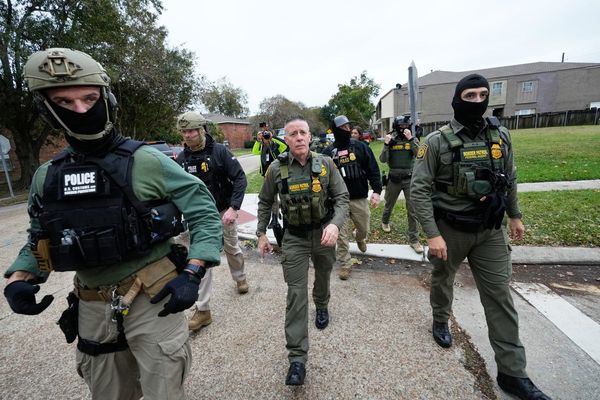
At the Team Zali shop there are sets of dangly teal earrings for $12 a pop. A dog bandanna will set you back $12; a tote bag $8.
You can buy a Team Zali swimming cap, a bucket hat or an umbrella.
Corflutes for the independent Warringah MP are, unsurprisingly, free. Team Zali will even deliver.
“Catch the new wave,” Zali Steggall’s website says.
Almost everyone expects Steggall to hold on to the seat she picked up from former prime minister Tony Abbott at the last election. The dog bandannas might help.
So might the fact her controversial Liberal opponent, Katherine Deves, has doubled down on her offensive comments about trans people.
Then there’s Team Zali’s advertising.
The latest figures from advertising on Facebook and Instagram show the team spent more than $10,000 on Facebook ads in the 30 days to 7 May.
In the digital space, $10,000 is a lot. University of Queensland political scientist, Dr Glenn Kefford, says the amount being spent by independents overall is “quite incredible”.
“We’re breaking new ground here,” he says.
Further up the graph of the independents’ spending, Allegra Spender, who’s trying to unseat Liberal MP Dave Sharma in Wentworth, has spent just over $28,000.

Monique Ryan, the independent challenging treasurer Josh Frydenberg in Kooyong, dropped $47,000 over the same period. UQ’s tracking site is monitoring the spend for almost 4,000 pages, and Kefford has outlined the spend from the so-called teal independents for the Conversation.
Alfie's not really sure about his new bandana but I'm certain he will grow to love it.https://t.co/5r1uKJ5lBq
— Dr Monique Ryan (@Mon4Kooyong) April 8, 2022
Dog bandanas are available in our store now.#auspol #mon4kooyong #dogs4mon pic.twitter.com/91oroq5HNk
He says the “big takeaway” from the data is the amount of money they’re spending in the digital space.
“The real leader here in terms of spend online is Monique Ryan,” he says.
“She’s spent [almost] $50,000 in just the last 30 days. Her messaging is in front of tens of thousands of voters – not just in her electorate but around Victoria, and in Sydney as well.”
The UQ data shows the Liberal party has spent about the same amount as Ryan’s team in the seat, while Labor spending is absent. The article in the Conversation notes that previous independents such as Tony Windsor did not have the sort of resources available now to the teals.
A Guardian Australia investigation of a broader range of advertising spending (including YouTube and Google as well as Facebook) found in some seats, Liberal MPs at risk from the teal independents were being outspent.
Kefford says the teals have a very effective strategy. Most of them share similar messages, and of course the colour. That means Ryan’s messages, for example, will get reinforced by Steggall’s, and so on, with people likely to see advertisements for different candidates.

“By spending this amount of money, [the independents] can layer their messages,” Kefford says.
“They’re talking about the issue that the major parties are completely ignoring … climate change. The majors don’t want to touch that with a 10-foot pole.
“It’s a message that’s resonating, so I think they’re hitting their brief. By focusing on climate change, they know their primary opponents, whether it’s Frydenberg or Sharma or whoever, there’s only so much they can say [because of the Coalition’s history on climate change policy].”
Dr Andrew Hughes, a political marketing lecturer at the Australian National University, says the digital approach lets independents target people in “micro” or “nano” ways – down to the level of a local coffee shop, for example.
“It’s reinforced, it’s smart, it’s effective, it’s lined up to the target market, it’s speaking their language,” he says.
“The theory was independent campaigns would fail because they couldn’t compete with the mass marketing [of the major parties]. But with digital and social media, as it’s more targeted and effective, that [advantage] gets washed away.”
Hughes says the teals’ individual campaigns are “integrated really well”.
“It’s consistent with the brand, and who they are, because they’re not trying to be more than centre left. Teal – it’s green with a hint of blue,” he says.
“From the colour, to the profile of the people they’re targeting for the merchandise – dog bandannas, earrings. I can’t see Labor doing dog bandannas … but it works well for Zali because it’s on brand.”







